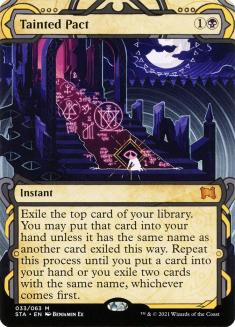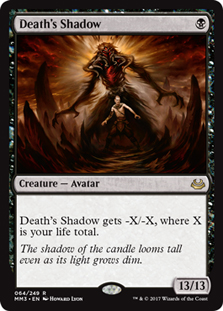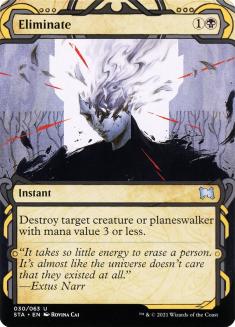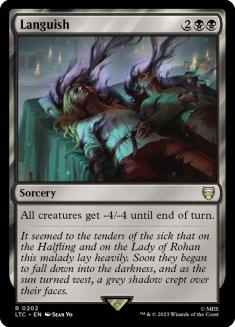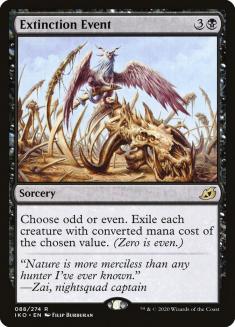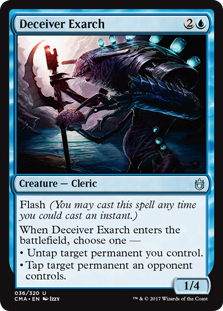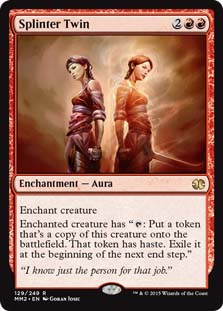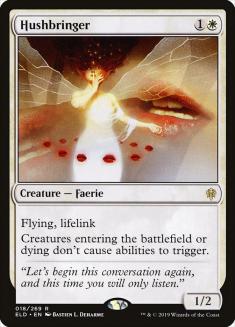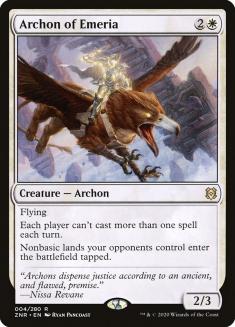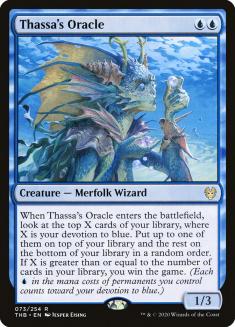Ten members of the MPL registered a variation of the Tainted Pact + Thassa’s Oracle combo this past weekend for the May Strixhaven League Weekend.
It was certainly the prevailing narrative of the tournament. Anytime a two-card combo kill from hand is even adjacent to competitive Constructed, folks are quick to question whether it’s a “Splinter Twin situation.” While the term is silly and overused, this time we actually have one.
Just in case you’re unaware, executing the combo is very simple. Cast Thassa’s Oracle to generate its trigger on the stack. Then respond with Tainted Pact and toss the entirety of your library into the garbage. You don’t need any devotion to win, making the combo foolproof against removal spells. Once the trigger has been generated you’re good to go barring any Stifle-esque interaction.
This combo has been a discussion piece since the previewing of Tainted Pact as a part of Strixhaven’s Mystical Archive. Sam Black quickly ran with the idea at the tail end of March.
The issue of course with developing a near-singleton deck is that it just takes time. This is a difficult nut to crack, and hasn’t really been explored in Magic before. Folks familiar with Hearthstone will recognize that singleton strategies are worth the squeeze if given proper incentive. In that game, your payoffs are getting to play with some extremely high-rate cards. Here the payoff is simply winning the game. Compounding the challenge is the need to also produce a functional singleton manabase, but with Historic’s deep card pool, folks did eventually figure out how to get the requisite number of “Dimir Guildgates” into their deck.
Once that got done and the breakthrough of “I can play two copies of each of my combo pieces” occurred, we ended up with a problem. This was obvious in retrospect, but not exactly intuitive at first glance — once you have drawn one copy of each of your pieces, then the other two left in the deck don’t do anything to inhibit your kill, so you can effectively double your odds of piecing together your combo.
I didn’t really pay that much attention until I saw this last week:
Yikes.
That certainly inspired me to play with the deck, and I found it as good as advertised. Shockingly consistent and of course it’s difficult to argue with the effectiveness of a four-mana, two-card combo kill.
So What Are The Problems Here?
The Deck
Long ago in a different life, I wrote an article speculating on the need to ban Death’s Shadow from Modern. Although we know of course that never ended up happening, I still stand by the words I wrote today given the knowledge I had at the time.
Essentially, the crux of my argument was that as the card pool naturally grows over time, Death’s Shadow has the unique advantage of being able to splice together all the strongest and most efficient cards. Death’s Shadow’s natural incentives to deal itself damage to deploy its namesake transformed life loss from pain to an asset.
I believe you can draw a similar argument today with Tainted Pact. While most players have decided to stick with Dimir, there’s been enough speculation and success with Grixis that it wouldn’t be surprising to me to take a similar approach — piecing together all the most efficient cards with the specific goal of assembling your combination.
The larger issue, however, is that as Historic’s card pool grows, Tainted Pact will continue to organically mitigate its weakness as a “singleton” strategy.
Let’s take a look at how August Andersen’s deck is constructed.
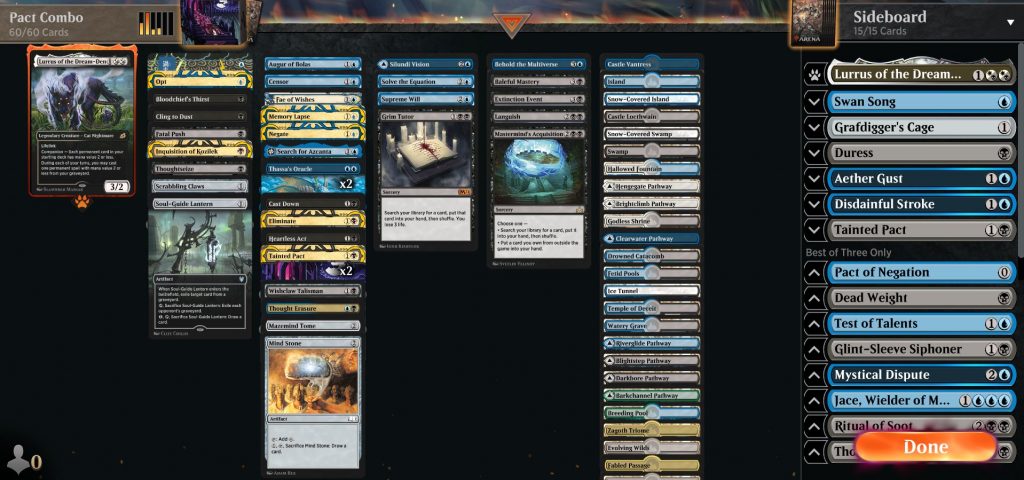
Once you get past the jarring nature of having to look at so many unique cards, it’s pretty easy to put the cards in the decklist into four buckets.
- Combo Pieces: Thassa’s Oracle + Tainted Pact
- Interaction: Discard, countermagic, and removal
- Tutors: Cards that expressly translate into a Combo Piece
- Card Draw: Cards that draw additional cards
So basically this is a combo-control deck. Tainted Pact wants to interact just enough to buy the time to assemble and protect its combo. This is exactly what made Splinter Twin so dangerous. It could play a normalized game with you before eventually killing you with its combo when your shields were down.
But what did I mean by “Tainted Pact will continue to organically mitigate its weakness as a singleton strategy?”
What’s the gap in practical terms between Eliminate and Heartless Act on Turn 2? Of course it’s possible that Heartless Act might not be able to interact with a threat, but over the life of a valid sample across a wide spread of matchups, I’d argue that the gap is effectively nonexistent.
Sometimes it will be larger. Languish and Extinction Event won’t always be at an equal power level and perhaps Brainstorm is weaker than Opt when your deck isn’t built to fully maximize it, but the point is that each card in Tainted Pact has a specific role and the names are irrelevant as long as there’s enough raw redundancy on deck real estate that can do their outlined job — keeping you alive or contributing to finding your combo and killing your opponent.
This is the real strength of the deck. A percentage of your spells must accomplish specific goals, and the large card pool of Historic makes that possible despite the “tight restrictions” placed on Tainted Pact by virtue of what its primary combo piece does.
Over time, as more strong versions of these effects and dual lands get printed, the gap will continue to shrink. While Tainted Pact will never be able to play with four copies of the best-in-class of each bucket of card, the gap will be minimal enough that the deck must be judged based on its combination rather than the drawback.
If the drawback becomes more artificial over time, we have to judge the play pattern.
The Play Pattern
Simply, Tainted Pact’s play patterns are hugely problematic.
Going back to the Death’s Shadow example, despite being a super-powerful strategy that combined efficiency with disruption, it still had to participate in the combat step. Death’s Shadow was beatable because there were multiple valid strategies against it. I got slaughtered in the Top 8 in a paper tournament (remember those?) by Abzan Midrange. I simply couldn’t produce enough threats to wade through a river of removal. You can grind out Death’s Shadow, or go way over the top of them despite their early-game strength.
Even Splinter Twin had clear weaknesses. Despite those weaknesses it was deemed too problematic to keep in the format. While not exactly using the combat step traditionally, Splinter Twin still required that you untap with a creature and incur risk by casting a four-mana enchantment. Removal spells could break it up as well as more niche effects (enchantment removal, Fogs, etc).
What can one do against Tainted Pact? Almost exclusively interact with it on the stack or bust.
As noted earlier, you don’t require any devotion to kill with Thassa’s Oracle. This means creature removal is effectively worthless against Tainted Pact. That leaves you with almost zero recourse against the combination if you aren’t playing blue, which has countermagic and cards like Nimble Obstructionist.
Discard can be effective, but it requires proper timing and pressure to back it up. Further, there’s plenty of redundancy on the pieces despite the deck only containing two copies of each — there are multiple ways to access a third Tainted Pact in your sideboard and Lurrus of the Dream-Den can rebuy Thassa’s Oracle.
White does have a few answers to the combo in cards like Hushbringer and Archon of Emeria. And while these are relevant, Tainted Pact is built like a control deck and can easily pick these creatures off. So if you aren’t playing blue you’re primarily just relying on speed and luck. The issue is further exacerbated by how the combo works. There’s not even the two-turn setup that Splinter Twin required to get past a summoning sick creature.
Two cards. Four mana. From hand. You’re dead.
Get It Out of Here
This deck is a problem.
Its deckbuilding weakness is overblown and will only shrink over time, the cards and strategies that can directly interact with its combo are minimal, and the deck has the ability to kill with blistering speed.
Realistically, Thassa’s Oracle should be the ban. The amount of positive things that result from the evergreen combo piece are virtually zero, and it’s nigh-inevitable that a new deck (or even an old one like Underworld Breach) will emerge using the Merfolk as its kill.
Strixhaven’s Mystical Archive has done a lot of good for refreshing Historic, but sometimes there ‘s collateral damage as a result of big risks. Let’s get Thassa’s Oracle out of the format and keep enjoying Historic.


